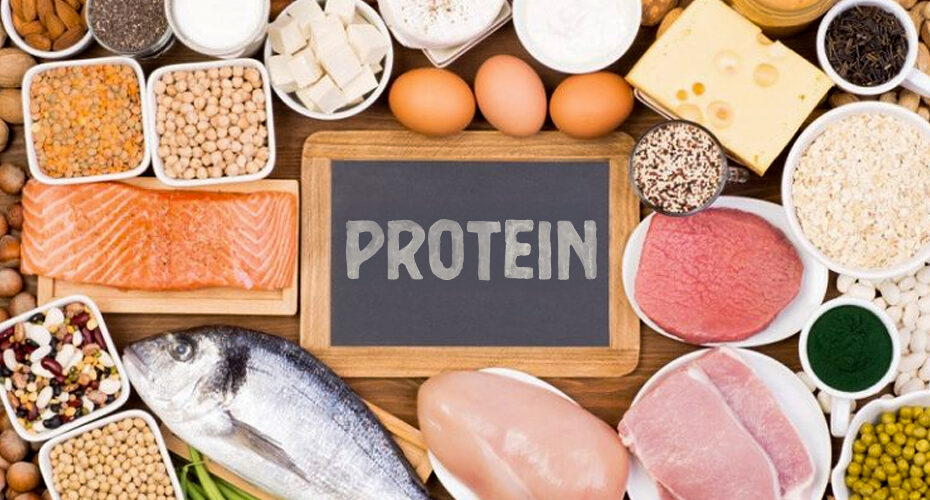“I just need to get more protein in during the day.”
We have all heard that, or even made that statement ourselves, right? Even though most of us know what protein is and that we should most likely be consuming more, how much protein should we have, when, and from what sources? How much additional protein is the right amount?
The Recommended Dietary Allowance (RDA) for protein is a modest 0.8 grams of protein per kilogram of body weight, or 0.36 grams per pound. Protein should account for 10% to 35% of your calories. So, if your daily needs are 2,000 calories, that’s 200-700 calories from protein or 50-175 grams.
Let’s break it down a bit further.
- An adult who weighs 165 pounds, or 75 kilograms, should consume 60 grams of protein per day.
- For adults over the age of 40, sarcopenia (losing muscle mass as you age) sets in. To help counter this, protein intake should be increased to 1 – 1.12 grams per kilogram bodyweight or 75-90 grams per day for the same 165 person in our example.
- For those who exercise regularly, lift weights or are training for a running or cycling event, the protein intake should be increased to 1.2 – 1.7 grams per kilogram bodyweight. Several articles state that excessive protein intake would be more than 2 grams per kilogram bodyweight each day.

Here’s a list of 10 ways to incorporate more protein into daily nutrition, with allergy-friendly options included for common allergens like dairy, nuts, gluten, and eggs:
Protein Smoothies
Ingredients: Blend non-dairy milk (soy, oat, or pea milk), banana, seed butter (sunflower or pumpkin), and a scoop of hypoallergenic protein powder (like pea or rice protein).
Allergy Options: Avoid nuts/dairy by using plant-based milk and seed butters.
Egg-Free Breakfast Scramble
Ingredients: Use crumbled tofu (for soy-tolerant kids) or chickpea flour scramble with veggies.
Allergy Options: For soy allergy, use mung bean-based or chickpea flour scrambles.
Add Beans or Lentils to Meals
Ideas: Mix lentils into pasta sauce, serve beans in quesadillas, or add to rice.
Allergy Options: Naturally gluten-free and nut-free; just watch for soy cross-contamination in processing.
High-Protein Pancakes or Waffles
Ingredients: Use gluten-free flour and add chia seeds, flaxseeds, or plant-based protein powder.
Allergy Options: Egg-free versions with flax/chia “eggs”; dairy-free milks.
Use Meat or Fish in Small Portions
Examples: Turkey or chicken bites, canned salmon or tuna with crackers, or grilled fish sticks.
Allergy Options: Skip if fish allergy exists; stick to poultry or beef.
Protein-Packed Snacks
Ideas: Roasted chickpeas, edamame (if soy is okay), beef jerky (gluten-free), or seed bars.
Allergy Options: Nut-free and dairy-free seed bars or jerky with clean labels.
Fortified Dairy Alternatives
Examples: Protein-fortified almond, soy, or pea milk.
Allergy Options: Choose based on specific allergy (e.g., oat or rice milk if nut/soy allergies exist).
Sneak in Tofu or Tempeh
Ideas: Blend silken tofu into smoothies, use tempeh crumbles in tacos or pasta sauce.
Allergy Options: Not for soy allergies; use lentil-based meat alternatives instead.
Baked Goods with Hidden Protein
Ingredients: Use oat flour + hemp seeds + applesauce in muffins or cookies.
Allergy Options: Egg-free, dairy-free, gluten-free options possible.
Protein Dips
Ideas: Serve hummus, black bean dip, or dairy-free Greek-style yogurt with veggies or crackers.
Allergy Options: Choose legume-based dips, avoiding sesame (in hummus) if needed.
Where To Begin
It can easily feel overwhelming to incorporate more protein into a daily eating routine. As with everything that we do, we first find our starting point. From there, we think about our goal and how best to get there. If you want to run a marathon, you don’t start your first day of running with a 20-mile jog. You have to work up to it. This same approach could work with nutrition, by making intentional but incremental changes daily until they become routine.
For example, you may want to start with breakfast and try different methods of adding protein. Liquid egg whites are a great source of protein and can be added to scrambled eggs without noticing. Half a cup of liquid egg whites (8 tablespoons) can provide up to 15g of protein (depending on the source). They can also potentially help stay satiated longer.
Another common method for increasing protein intake is by using a supplement, such as protein powder. If you want to use a protein supplement, pay close attention to the ingredients. It has been recommended to find a protein powder with 2 grams or less of saturated fat, 5 grams of sugar or fewer, and about 200 or fewer calories. Bonus points for no transfat or partially hydrogenated oils. Our friends at Results By Design and Next Level Nutrition both sell fantastic protein powders.
Further Reading
- Mayo Clinic: “Are You Getting Too Much Protein?“
- Harvard Health: “How Much Protein Do You Need Every Day?“
- American Heart Association: “Protein: What’s Enough?“
- Rise Fitness blog: “Using AI to Help With Meals“
We highly recommend speaking to your doctor about your own health and nutrition goals and implement meal plans at their discretion. The information provided here should be used only as a guide.
